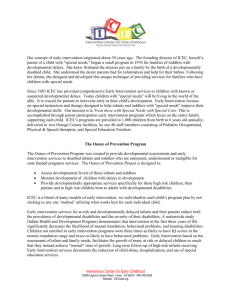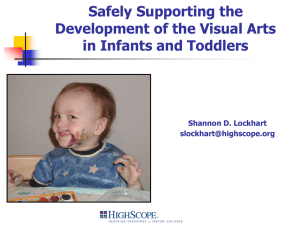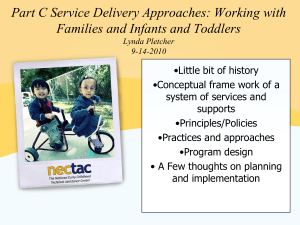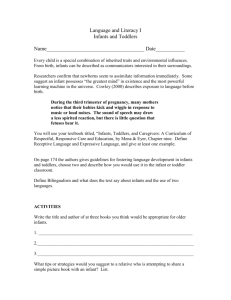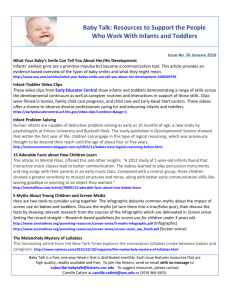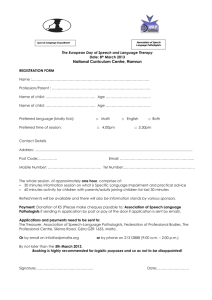Quality Assessment and Intervention with Infants and Toddlers
advertisement
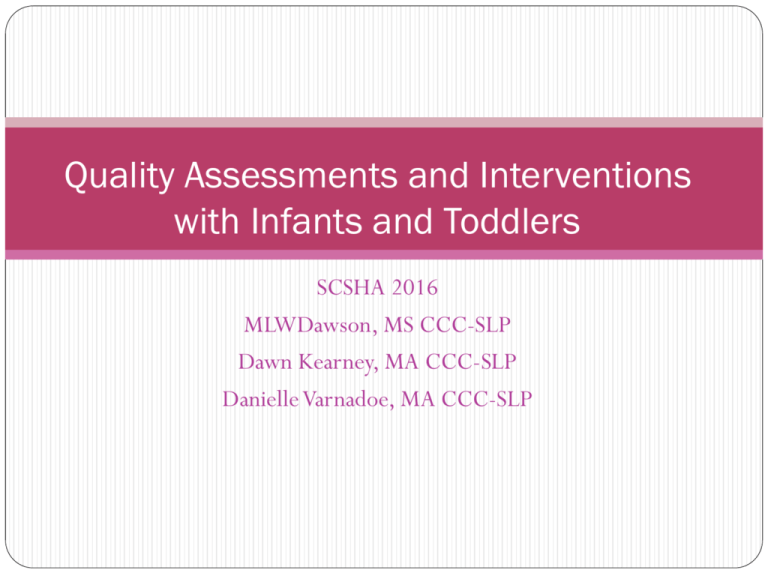
Quality Assessments and Interventions with Infants and Toddlers SCSHA 2016 MLWDawson, MS CCC-SLP Dawn Kearney, MA CCC-SLP Danielle Varnadoe, MA CCC-SLP Agenda Disclosures/Introductions Review of Risk Factors for Speech and Language Disorders/Delays Evidence-Based Assessments Evidence-Based Interventions Conclusion Questions MLWDawson Non-Financial Disclosure: Michelle L. W. Dawson, MS CCC-SLP is VP of Governmental Affairs for SCSHA, she is also Convention Co-Chair for the 2016 SCSHA Convention Financial Disclosure: Michelle L.W. Dawson, MS CCC-SLP is an employee of Sprout Pediatrics and has a contract with NSS for development of a 6 hour webinar for Infantile Spasms and Treatment of Oropharyngeal Dysphagia Biography: Michelle completed her MS in Communicative Sciences and Disorders from James Madison University in Harrisonburg, VA in 2009. She has worked in a variety of settings including the public schools, in-patient and out-patient rehabilitative hospitals, as well as spent may years in early intervention. She is currently working on her BCS-S licensure as treating feeding and swallowing disorders across the life span is her first love within the SLP Scope of Practice. Dawn Kearney Financial/Non-financial Disclosure Statement Dawn is the Co-owner of Midlands Therapy Services (2003) based in Lexington, SC and Southland Therapy Services (2006) based in Savannah, GA. Both agencies provide early intervention services, speech/language, feeding, OT and PT, to infants and toddlers in many parts of SC and GA. Biographical Information Dawn received her Master’s degree in Speech Pathology and Audiology from South Carolina State University in 2000. She holds both the certification of clinical competence (CCC-SLP) from ASHA and is licensed in the state of South Carolina. Dawn also holds the South Carolina Part C Credential through BabyNet. Dawn began providing speech and language therapy to infants and toddlers in 2001 through the BabyNet system after the premature birth of her oldest son. She has extensive experience in many early childhood diagnoses and delays and is passionate about making a difference in her patients and their families’ lives. Danielle Varnedoe: Introduction and Disclosure Statement Financial/Non-financial Disclosure Statement Danielle Varnedoe is not a service provider under Part C services in the state. She is a non-paid consultant to BabyNet and reviews speech-language evaluations when eligibility determination for Part C services is in question. No relevant financial relationship with BabyNet exists. Biographical Information Danielle Varnedoe is on faculty in the Department of Communication Sciences and Disorders at the University of South Carolina. She is the director of the USC Speech and Hearing Research Center. Danielle has interests in both the early identification of communication disorders in infants and toddlers and in the differential diagnosis of speech sound disorders in children. Review of Risk Factors and Red Flags for Expressive Communication Disorders/Delays What does a child with an Expressive Communication Delay look like? “Generally these children are the toddlers who are slow at producing first words and word combinations and may persist in having grammatical errors as syntax develops. They are the children who show no signs of developmental delays, such as cognitive, emotional or sensory problems, but who are demonstrating difficulty learning language” (Olswang, Rodriguez, & Timler, 1998). Most Speech Language Pathologists agree that a child with less than a 50 word vocabulary and who is not yet putting 2 words together by age 2 is at risk for an Expressive Communication Delay. However, research and review of studies on “late talkers” have provided SLPs with more diagnostic markers/red flags. These red flags can help with the clinical decision making process in differentiating between those children who may outgrow their language delay from those who will most likely continue to display deficits in expressive language development. Red flags for expressive communication delay: • • • • • • • • Family History A gap in receptive/expressive language skills on a speech and language evaluation Decreased vocalizations or lack/reduced babbling Limited phonemic vocabulary Inability or difficulties with imitating sounds, words or word combinations Decreased play skills Reduced/delayed social skills Behavioral issues Family History “Thirteen studies recorded family history of speech, language and/or learning difficulties, with 11 identifying this as a risk factor for childhood speech and language impairment” (Harrison & McLeod, 2010). A gap in receptive/expressive language skills on a speech and language evaluation “The consensus suggestions that toddlers with significant expressive and receptive language delays of 6 months or more are most at risk for continued language delay. Further, for those children delayed in both comprehension and production, the larger the comprensionproduction gap, the poorer the prognosis” (Oswnang, Rodriguez, Timler, 1998). Decreased vocalizations or lack/ reduced babbling “Children who show late canonical babbling may also show a delay in their expressive language ability, but not a delay in their receptive language ability in understanding individual words at 2 years of age” (Oller, Eilers, Neal, & Schwartz 1999). Limited phonemic vocabulary “Various researchers have conducted in-depth analyses of the phonological characteristics of samples of spontaneous language collected from “late talkers” (L-T). In general the analyses of the samples showed that L-T are less talkative than normal children of the same age and that they have a smaller phonological inventory for both vowels and consonants. In addition, various types of analyses confirmed the presence of simpler syllabic structures amongst L-T, characterized by a preponderance of open syllables consisting of a single vowel or a ‘consonant plus vowel’ sequence” (Chantel Desmarais et al, 2008). Decreased play skills “Late talkers seem to engage in higher frequency of manipulations, handling, and grouping of toys & objects than in combinatorial/thematic play and symbolic play” (Olswang, Rodriguez, Timler, 1998). Behavioral issues Clinically, there appears to be a strong association between language difficulties and behavior problems. “Studies on subjects with Specific Language Impairment have in fact demonstrated that the presence of a language disorder constitutes a moderately high risk i.e. 2.5-4.2 times greater, that these children will also present with behavioral problems” (Desmarais et al, 2008). Is there a link between recurrent otitis media and expressive communication delay? No, the research findings do not confirm a link between children with recurrent otitis media & vocabulary delay. However, studies are showing that otitis media has an influence on articulation skills (Desmarais et al. 2008). Now that we know what the clinical evidence tells us about the characteristics and red flags of an expressive communication delay, Let’s talk EVALUATION AND ASSESSMENT Evaluation and Assessment Quality Assessment = Quality Intervention Receptive and Expressive Language Communication Preliteracy Reading/Spelling Educational Vocational Age Appropriate Delayed Birth Infant Toddler Preschool School-Age Adulthood Evaluation Evaluation and Assessment Common Screening Instruments Battelle Developmental Inventory-2 Edition (ST) (2004) Overall: Sensitivity: 0.72–0.93; Specificity:0.79–88 “considered “moderately accurate”. Communication Domain: Sensitivity: .72; Specificity: 79 (Elbaum, 2010) ____________________________________________ Battelle Developmental Inventory – 2nd Edition (BDI-2 ST)* S.D. Sensitivity Specificity -1.0 .90 .65 -1.5 .94 .87 -2.0 .79 .93 *Elbaum, 2010) Battelle-2 (ST) Sensitivity “The BDI-2 Screening Test accurately identified the children who are at risk in the autistic and cognitive delay group better than in the other delay groups. The developmental and speech and language delay groups had many fewer children who were correctly identified as being at risk for developmental delay. Specificity “For all groups, 79% or more children who were not at risk for developmental problems were identified as not having developmental problems. The BDI-2 Screening Test accurately identified the children who were not in a risk group in the motor and developmental delay group better than in the other delay groups. Reference: Early Childhood Developmental Screening: A Compendium of Measures for Children Birth to Five. OPRE Report, November, 2014. Common Evaluations Normed Referenced Preschool Language Scale -5 (2011) (English and Spanish) Problem: Score skills as “present” or “absent” but does not provide a description of what the child can do and how they do it. e.g. “…uses 1 word” “…uses 5 words” The real question should be: how are they used? What is the quality of these words? Home Communication Questionnaire included Preschool Language Scale - 5 S.D. Subtest Sensitivity Specificity -1.0 AC EC AC .83 .86 .93 .77 .85 .66 EC .94 .75 AC EC TLS* .96 .95 .81 .95 .63 .83 -1.5 -2.0 *Total Language Score Common Evaluations Receptive-Expressive Emergent Language Scale-3 (2003) Sensitivity and specificity not stated in the manual. More of a screening instrument; needs to be supplemented with other assessment procedures. Rule of Thumb Regarding Tests Supplement TESTS with ASSESSMENTS (What are the child’s abilities and needs within his/her natural environment?). Tests should not be used to measure progress. Tests should not solely be used to qualify infant/toddlers for services. USE INFORMED CLINICAL OPINION -------------------------------------------Technical Information • Providers should purchase and use the latest version within a year of publication. • Tests should be revised every 15 years. INFORMED CLINICAL OPINION Elements that go into ICO: • Appropriate education and training • Knowing normal development • Knowing the evidence (because test scores do not always tell the right story) • Previous experience • Sensitivity to cultural needs • Family’s perceptions and needs What the Evidence Says • Late onset of canonical babbling (Oller, Eilers, Neal & Schwartz, 1999). • Limited words or word attempts (Paul & Roth, 2011). • Delayed development in the area of phonology Restricted syllable structure (Pharr, Ratner, & Rescorla, 2000) Small phonetic repertoires (Carson, Klee, Carson, & Hime, 2003; Paul & Roth (2011). • Limited pragmatic efforts to manipulate environment (Paul & Roth, 2011). • Significant delay (>6 months) in comprehension and production (Paul, 2007; Ellis & Thal, 2009). Other Assessments MacArthur-Bates Communicative Developmental Inventories-2nd Edition (Fenson, et.al., 2007) Inventories: Words and Gestures (8-18 months); Words and Sentences 16-30 months) 50th percentile-WNL <10 percentile – significant delay _________________________________________________________ Up to the 11th percentile: good sensitivity and specificity 11th percentile: sensitivity - 0.68; specificity - 0.98 19th percentile: sensitivity - 0.81; specificity - 0.79 49th percentile: sensitivity - 1.00; specificity - 0.44 (Heilmann, et.al., 2005) Other Assessments Language sampling procedures; needs to be done over time. Independent measures of phonology (quantity + quality); needs to be done over time for reliability purposes (Morris, 2009). See forms. Pragmatic assessment (more detailed information) http://www.jtc.org/pragmatic-skills-checklist/ DIAGNOSIS Definite Yes: Receptive and/or expressive language disorder (F80.2) for mixed; (F80.1) expressive only Phonological disorder (F80.0) Definite NO: Articulation Delay Childhood Apraxia of Speech (CAS) (Davis & Velleman, 2000; ASHA Practice Portal for CAS) SAMPLE CASES Case 1 - Diagnosis of CAS Case 2- Battelle findings Case 3- Lack of information Case 4 – Really a lack of information Review of EBP Interventions Let’s begin with legal/policy review What does IDEA Part C Say? Early Intervention Services in Natural Environments Code 303.126 Each system must include policies and procedures to ensure, consistent with other provisions in the part, that early interventions services for infants and toddlers with disabilities are provided A. To the maximum extent appropriate, in natural environments; and B. In settings other than the natural environment that are most appropriate, as determined by the parent and the IFSP team, only when early intervention services cannot be achieved satisfactorily in a natural environment Natural Environments Code 303.26 “settings that are natural or typical for a same-aged infant or toddler without a disability, may include the home or community settings, and must be consistent with the provisions of code 303.126 (Early Intervention services in natural environments). What does Babynet Say? Family Outcomes: “ The Part C program recognizes that families play a crucial role in optimizing their child’s development and aims to enhance the capacity of families to meet the special needs of their infants and toddlers. Services are based on an Individualized Family Service Plan (IFSP) that is jointly developed by family members and service providers, taking into account the child’s developmental needs and the family’s concerns and priorities. Part C also recognizes that infants and toddlers with disabilities have a right to receive services as part of family and community life within the context of everyday routines, experiences, and activities with familiar people. Early development is best supported when services are provided in the child’s home or in places or programs where young children play.” Babynet General Assembly Report December 2015 What does DEC Say? 8 Guiding Principles: Leaders, Assessment, Environment, Family, Instruction, Interaction, Teaming and Collaboration, Transition E1: Practitioners provide services and supports in natural and inclusive environments during daily routines and activities to promote the child’s access to and participation in learning environments F1: Practitioners build trusting and respectful partnerships with the family through interactions that are sensitive and responsive to cultural, linguistic, and socio-economic diversity F6: Practitioners engage the family in opportunities that support and strengthen parenting knowledge and skills and parenting competence and confidence in ways that are flexible, individualized, and tailored to the family’s preferences INS5: Practitioners embed instruction within and across routines, activities, and environments to provide contextually relevant learning opportunities INT3: Practitioners promote the child’s communication development by observing, interpreting, responding contingently, an providing natural consequences for the child’s verbal and non-verbal communication and by using language to label and expand on the child’s requests, needs, preferences, or interests ASHA continued Technical Report: Roles and Responsibilities of Speech-Language Pathologists in Early Intervention Great Resource!!! History Overview Characteristics of Infants/Toddlers who receive EI 4 Guiding Principles: 1. 2. 3. 4. Services are family centered and culturally and linguistically responsive Services are developmentally supportive and promote children’s participation in their natural environments Services are comprehensive, coordinated, and team based Services are based on the highest quality of evidence that is available ASHA continued Technical Report: Roles and Responsibilities of Speech-Language Pathologists in Early Intervention Functions of SLP Prevention Screening, Evaluation, and Assessment Planning, Implementing, and Monitoring Intervention Consultation and Collaboration with the Family and Other Team Members Service Coordination Transition Planning Advocacy Awareness and Advancement of the Knowledge Base in Early Intervention ASHA continued Position Statement: Roles and Responsibilities of Speech-Language Pathologists in Early Intervention Our Roles should be implemented in accordance with these guidelines: 1. Services are family centered and culturally/linguistically responsive 2. Services are developmentally supportive and promote children’s participation in their natural environments 3. Services are comprehensive, coordinated, and team based 4. Services are based on the highest quality of evidence that is available What does ASHA say? IDEA Part C Issue Brief: Natural Environments Implications for ASHA Members: “Natural environments” and “family-centered” practices involve helping families learn how to encourage their children’s participation in everyday situations and are the focus of members’ intervention in Part C That leaves EI SLP’s where? Intervene in Natural Environments Acceptable But Also Acceptable Living Room Daycare Kitchen Clinic Backyard Hospital Out-Pt Wal-Mart Grocery Store Park Mall Chick-fil-a not ideal but for some circumstances only options: Rural Settings Therapist Safety Interventions in a Natural Environment Do Bringing an object outside of their SES for tx and take it away: Examples: Tablets and expensive toys Not Bringing in foreign objects to medically fragile homes Include If you use OME tools, do not share between Pts!!! Leave That Bag At Home! How about Co-Treatments? ASHA Technical Report, Guiding Principle Three: “Services are Comprehensive, Coordinated, and Team Based” DEC TC2: “Practitioners and families work together as a team to systematically and regularly exchange expertise, knowledge, and information to build team capacity and jointly solve problems, plan, and implement interventions” So… Do this “Thang”! Even with ABA!!! Let’s look at EBP Interventions to Incorporate First 100 Words COREVocab These are actions! Language acquisition happens on the go! No Flashcards Required Sign Language Use in conjunction with the spoken word SLP and Family Model Hand over hand with the Pt Focus on the Core Vocabulary Fine Motor/Gross Motor deficits can hinder this tool AAC Does the Child have the prerequisite skills for the task? •Gross Motor Skills •Fine Motor Skills •Head/Neck Control •Vision Remember Consult the TEAM!! AAC AAC should mean: teaching the child to say what they want to say …rather than saying what we want them to say. AAC AAC means learning language, NOT operating switches/devices Core Vocabulary plus fringe vocab 80/20 approximate ratio Motor Memory… Trial and error is how we learn. AAC AAC has to be multimodal Not hand over hand, but we should model instead with aid of gestures, facial expressions, and our posture…engage their AAC device in language exchange Just Say No to NSOMEs Transference of Part to Whole 2. Strength 3. Task Specific Brain Organization 4. Lack of Effect on Mouth Awareness 5. Lack of Evidence 1. Lof, G., Watson, M. (2010). Five Reasons why Nonspeech Oral Motor Excrises (NSOMEs) Do Not Work. (SIG 16 Perspectives on School-Based Issues, 11, 109-117. HEP Home Exercise Program Not just for insurance documentation!!! Family/Caregivers help to create this, but they rely on the guidance of the expert…you! Make Interventions Fun! But... Balance with Tough Love Let’s Try a Few Targeted Language Core Vocab: In Out Open Close Play Go Fringe Vocab: Dirty Leaves Door Ding-Dong Targeted Language: Core Vocab: Eat Open Pour In Out Want More All Done Fringe Vocab: Cookie Shapes Animals Considerations for Special Populations How does this work with Medically Complex Pts? American Academy of Pediatrics: “Create frequent opportunities that allow for ‘learning in the natural environment’ rather than in simulate ‘treatment’ situations” “Utilizing methods of ‘coaching’ as a model for families Remember their unique ADL needs require FXNL ST How does this pertain to Feeding/Swallowing Pts? •Practice within your Scope of Practice •This is NOT OMEs •CSE vs. Instrumental •Billing/Coding concerns exist within Babynet… however SCSHA is working to address this issue Tiny Soap Box If it’s not functional, not part of their natural environment, then why are we introducing it? Food is Not Plastic Food does Not Vibrate Conclusion The diagnosis is made by more then just the numbers. Look for the waving red flags! Use the evidence and provide details – make it count! Family Centered, Fxnl ADL’s, Natural Environment! Questions References Adams, R. C. MD., Tapia, C. MD., and The Council on Children with Disabilities. (2013). Clinical Report: Early Intervention, IDEA Part C Services, and the Medical Home: Collaboration for Best Practice and Best Outcomes. Pediatrics, 132 (4), 1073-1086. Childress, D. C. (2004). Special Instruction and Early Intervention: Best Practices in Early Intervention. Infants andYoung Children, 17(2), 162-170. DEC Recommended Practices in Early Intervention/Early Childhood Special Education 2014. (2016, April 14). Retrieved February 01, 2016, from http://www.dec-sped.org/recommendedpractices BabyNet: Ensuring Quality Services for Infants and Toddlers with Disabilities and their Families within the BabyNet Early Intervention System: An Analysis of Current and Needed Resources. (December 2015). IDEA Part C Issue Brief: Natural Environments. (n.d.). Retrieved February 01/2016, from http://www.asha.org/Advocacy/federal/idea/IDEA-Part-C-Issue-Brief-Natural-Enviornments/ Interventions for children with speech, language and communication needs: An exploration of current practice Child Language Teaching and Therapy October 2012 28: 325-341, Lof, G., Watson, M. (2010). Five Reasons why Nonspeech Oral Motor Excrises (NSOMEs) Do Not Work. (SIG 16 Perspectives on School-Based Issues, 11, 109-117. Roles and Responsibilities of Speech-Language Pathologists in Early Intervention: Position Statement. (n.d.). Retrieved February 01/2016, from http://www.asha.org/policy/PS2008-00291/ Roles and Responsibilities of Speech-Language Pathologists in Early Intervention: Technical Report. (n.d.). Retrieved February 01, 2016, from http://www.asha.org/policy/TR2008-00290/ References Desmarais, C., Sylvestre, A., Meyer, F., Bairati, I., and Rouleau, N. (2008). Systematic review of the literature on characteristics of late-talking toddlers. International Journal of Language and Communication Disorders, 43, 361-389. Harrison, L.J. and McLeod, S. (2010). Risk and Protective Factors Associated With Speech and Language Impairment in a Nationally Representative Sample of 4- to 5-Year-Old Children. Journal of Speech, Language, and Hearing Research, 53, 508-529 Oller, D.K., Eilers, R.E., Neal, R.A., & Schwartz, H.K. (1999). Precursors To Speech in Infancy: The Prediction Of Speech and Language Disorders. Journal of Communication Disorders, 32, 223245. Oswang, L.B., Rodriguez, B., Timler, G. (1998). Recommending Intervention for Toddlers With Specific Language Learning Difficulties: We May Not Have All the Answers, But We Know a Lot. American Journal of Speech-Language Pathology, 7, 23-32.


